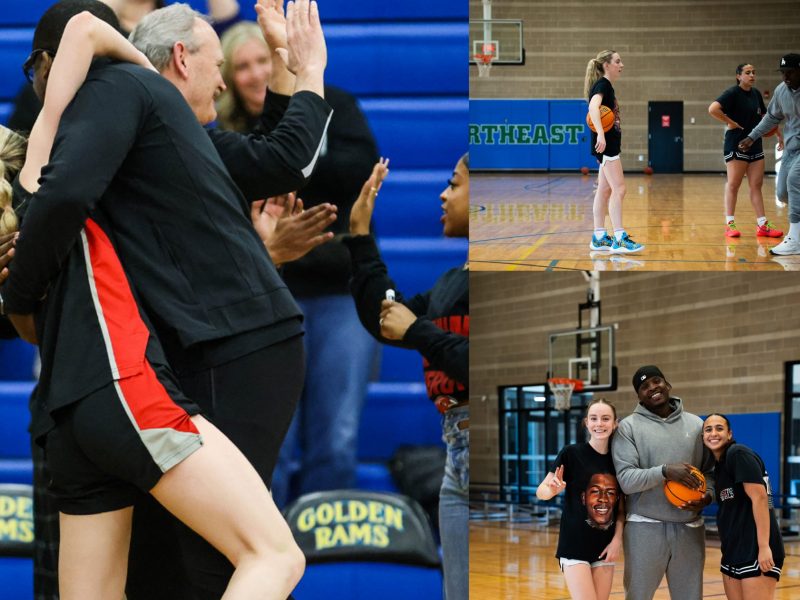At center circle, Dana Dobbie awaits the official’s signal. After the whistle blows, Dobbie battles through the opposition’s stick and flings the ball straight up into the air. Using her size and determination, she jumps and catches the ball at the highest point and kick-starts the Terrapin women’s lacrosse team’s offense.
Dobbie has collected more draw controls than any other player in NCAA history. And that desire and determination used to win a draw has spread to every facet of her game.
The two-time ACC Player of the Year didn’t become one of the top players in the nation overnight. Dobbie began playing lacrosse at just age 4 in Guelph, Ontario. As she got older, she had to play in boy leagues, as there were no girl leagues for her to join. And even as she has developed into one of the nation’s top players, Dobbie had to deal with near-career ending injuries and transferring between her sophomore and junior seasons.
From beating the boys at age 13 to becoming a Tewaaraton Trophy finalist, Dobbie has earned national acclaim for her spirited play.
n Early days in Canada
Dobbie’s father, Garry Dobbie, and her older brother, Jason Dobbie, both played lacrosse and got her hooked on the sport at the tender age of 4.
“I grew up in a really small town and lacrosse was one of the big sports,” Dobbie said. “It started in the backyard. My brother and I would play one-on-one and my dad would be teaching us. When I was four, they put me in T-ball, soccer and lacrosse. My dad said, ‘pick the one you like the most,’ and it was lacrosse – it has always been lacrosse.”
Growing up, Dobbie’s father coached her on boy’s club teams and taught her fundamentals that have carried over into her game today. She was forced to play on boy’s lacrosse teams until she was 14 years old and finally joined a women’s club team.
Dobbie tried out for Canada’s under-19 team at the age of 13, but did not make the cut. She would make the Canadian junior team in 2003 at age 17 and the Senior Canadian World Cup Team in 2005, although surgery derailed the stint.
After her time in Canada, Dobbie moved on to Ohio University, where her career hit rock bottom and nearly ended.
n Injury-riddled Ohio
Having proven her worth on Canadian club teams, Dobbie’s next step was to take her game to the college level, and she chose Ohio.
“They gave me a call and they asked me to come play,” Dobbie said. “I knew some people on the team, so I was so excited, and I knew it was going to be an awesome experience.”
But Dobbie’s career with the Bobcats did not work out as well as she had hoped.
In the midst of a 34-goal freshman campaign, Dobbie injured both her ankles and did not finish the season. It happened again her sophomore year, and after the season she discovered she had torn ligaments in both ankles and needed surgery.
This led to a redshirt junior season and a disgruntled midfielder. The injuries also left Dobbie seeking a clean slate at a different school.
“It just got to the point [where] I didn’t have this in mind,” she recalled. “I wanted to come out and be a better lacrosse player and really enjoy it. I was not happy, always on crutches, watching practice and not playing in practice. I just went in and talked to my coach asked if I could have a fresh start and transfer.”
Dobbie considered both Denver, where current Terps head coach Cathy Reese and associate head coach Jen Adams were employed at the time, and the Terps, where Adams made history as a player.
The rising star chose Denver because of the coaching staff, but before she signed on to play for Denver, Reese and Adams moved on to join the Terps. The switch made Dobbie’s choice easy.
“I lucked out,” Dobbie said. “I got the school I wanted, the coaches I wanted and the team I wanted.”
After her experience in Ohio, Dobbie couldn’t be happier to leave and become a Terp.
“To be here is a dream come true and something I am thankful for every day because I have been on the other side of it,” Dobbie said.
n College Park, finally
After all the movement, Dobbie settled in as a Terp, and her career took off.
Dobbie used her first season in College Park to build chemistry with her teammates. Even with just one season together, Dobbie has a very strong rapport with her teammates, especially senior midfielder and fellow Tewaaraton finalist Kelly Kasper.
“We just both know where each other will be and our strengths,” Kasper said. “After last year and this fall, we have really gotten to know how each other plays to a T. I know everything that she will do, and she knows everything I will do.”
Right away, Dobbie made her presence felt. She scored 53 goals en route to her first set of ACC Player of the Year and Tewaaraton finalist honors.
And while many players might have peaked with those accomplishments, Dobbie just got better.
This season, Dobbie has taken her game to another level. She scored 69 goals and set the single-season mark for draw controls with 123, eclipsing the previous mark of 113 by Georgetown’s Coco Stanwick, on March 3 against Loyola (Md.).
Dobbie’s past struggles in Ohio have given her an unmatched passion for the game that has become contagious for her teammates.
“I have never seen anyone who loves lacrosse more than she has,” Kasper said. “She is out here before practice, and she is out here after practice. She just puts her whole heart and everything into it.”
This passion and positive attitude has allowed Dobbie to lead by example and bring out the best in her teammates. And her exceptional stickwork has allowed her to become the NCAA leader in draw controls, with 331 in her career.
“She is excellent at draw controls; however, she spends a lot of time working on them,” Reese said. “It’s not something you wake up with one day and all of a sudden you’re great at taking the draw. She spends the time and puts in the effort working on it.”
Her extra work has also allowed her to develop some creative shots, including her “flip-shot” – a behind-the-back shot.
With all of the extra work and individual accolades, Dobbie is just happy to be in the position she is now.
“At home, there are no accolades for something like this,” Dobbie said. “There is no All-Canadian or MVPs or player of the year; it’s something we play for fun. That’s why I don’t let those awards put pressure on me because I’m not used to it, and I don’t think about it at all. Playing here at Maryland, I still can’t believe that it’s real.”
Since becoming a Terp, Dobbie has felt a change in the team culture.
At Ohio, a national championship is a lofty goal. As a Terp, it’s expected. And with the individual accolades piling up, Dobbie still wants one more trophy to celebrate with her teammates, who she credits for putting her in position for individual recognition.
“It’s something that, at Ohio University, it was something we talked about and that we wanted,” Dobbie said. “Now at Maryland, we know that if we play our game and our best games, it’s attainable. It’s something different. We know that if we want it and do it, it’s something that we can have at the end of the season. We want to be the last team standing, and I know that anything other than that would be heartbreaking.”
bkapurdbk@gmail.com


